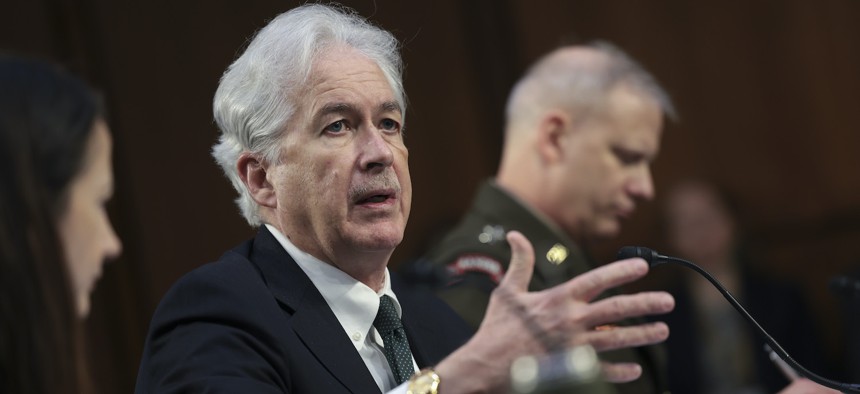Sharing secrets has been ‘effective’ against Russia, but the tactic has limits, CIA chief says

Central Intelligence Agency (CIA) Director William Burns testifies before the Senate Intelligence Committee on March 10, 2022. Getty Images / Kevin Dietsch
It’s just one of the new areas for a spy agency grappling with tech-driven changes.
Declassifying intelligence to defuse Russian narratives has “played a very effective role” in the months-long war in Ukraine, according to the head of the Central Intelligence Agency, particularly when it’s part of a broader strategy. But its usefulness has limits when it comes to cyber threat intelligence.
“The decisions to declassify intelligence are always very complicated ones, but I think when President [Joe] Biden has decided very carefully and very selectively to make public some of our secrets, it's played a very effective role over the course of the last six months, and I think it can continue to—again, if we make it the exception, not the rule,” William Burns, the director of the CIA, said during a keynote at the Billington Cybersecurity Summit on Thursday.
Burns said recklessly handling of information was the “surest way” to lose access to good intelligence, but with respect to the Russian invasion of Ukraine, it has helped counter false narratives out of the Kremlin.
“I think it's been a very important means of denying Vladimir Putin something that I've watched him employ too often in the past, which is creating false narratives, trying to blame the Ukrainians, to create false provocations in the run up to the war,” Burns said.
“And I think what we were able to do working with our allies and partners is to expose the fact that Putin's war is a naked, unprovoked aggression as well and I think that's played—that very selective, very careful declassification—played a perfect role.”
But declassifying intelligence might not work for every scenario, particularly when it comes to declassifying cyber threat intelligence, stressing that declassification needs to be done “carefully.”
“I think we're gonna have to be careful looking at other instances, whether it's in terms of cyber threats or other kinds of challenges that the United States and our allies will face in the future,” Burns said.
Adapting to the digital world
The CIA is also coming to terms with rapid changes in technology and how they might force the agency to change its approach to human intelligence gathering.
“Certainly, the revolution in technology in the era of ubiquitous technical surveillance and smart cities—it's transformed the way in which our case officers conduct our tradecraft and do work business overseas,” Burns said.
He said adversaries can now use artificial intelligence and machine learning to mine years of past data and “discern patterns in our activities that make it a lot more complicated to conduct our tradecraft and our profession and human intelligence in particular, in the way that we were accustomed to doing it for years and years before.”
In an effort to adapt, the agency has created one mission center to counter China and another, the Transnational and Technology Mission Center, that aims to better understand “patterns and innovation” in commercial technologies.
“We have a contribution to make in competition with China and competition with other rivals, and trying to help policymakers understand what's the best way to shore up vulnerabilities in our supply chain. How do we compete successfully in critical spheres, as all of you know very well, from semiconductors to quantum computing to synthetic biology as well. So we're putting a lot of energy and resources into those efforts,” Burns said.
He said about one-third of CIA officers work on tech-related issues, from cybersecurity to digital innovation.
In April, the CIA hired its first chief technology officer: Nand Mulchandani, who previously led the Pentagon’s AI center. Mulchandani is charged with producing the agency’s 10-year technology strategy and fostering links between the agency, academia, and the commercial and public sectors.
Burns said it is important for the CIA to have a technology strategy that “draws on all the talent and all the resources we have,” particularly in semiconductor supply chains.
Mulchandani’s “first charge is to work, again, with all of our colleagues across CIA to produce for the first time a serious agency-wide technology strategy looking out over the long term, so I think there are a lot of opportunities here,” Burns said.






